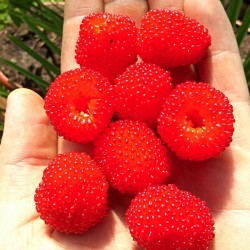Menu
-
MenuZpět
- Home
-
Kategorie
-
-
Kategorie
-
Zeleninová semínka
-
Odrůdy podle země
- Odrůdy z Arménie
- Odrůdy od BiH
- Odrůdy z Chorvatska
- Odrůdy z Francie
- Odrůdy z Německa
- Varieties from Greece
- Varieties from Hungary
- Odrůdy z Indie
- Varieties from Italy
- Odrůdy z Japonska
- Odrůdy ze Severní Makedonie
- Varieties from Peru
- Varieties from Russia
- Varieties from Serbia
- Odrůdy ze Slovinska
- Varieties from Spain
- Varieties from Thailand
- Odrůdy z Turecka
- Varieties from USA
- Semena rajčat
- Semena kukuřice
- Tykev rodina
- Rodina fazole
- Semena okurky
- Semena papriky
- Rodina mrkve
- Cibulová rodina
- Salátová semínka
- Rodina brambor
- Rodina zelí
- Semena ředkvičky
- Rodina z červené řepy
- Semena melounu
- Melounová semínka
- Semena květáku
- Slunečnicová rodina
-
Odrůdy podle země
- Ovocná semínka
- Chili semínka
- Semena léčivých bylin
- Semena horolezeckých rostlin
- Stromy - keř - semena
- Palmová semínka
- Semena okrasných trav
- Semena tabáku
-
Zeleninová semínka
-
-
-
-
- NOVÉ PRODUKTY
- Dodání - platba
- Vytvořit účet
- FAQ
- Domů
-
- Zeleninová semínka
- Odrůdy podle země
- Odrůdy ze Severní Makedonie
- Odrůdy z Chorvatska
- Odrůdy z Turecka
- Odrůdy od BiH
- Odrůdy z Japonska
- Odrůdy z Indie
- Odrůdy z Arménie
- Odrůdy z Francie
- Odrůdy ze Slovinska
- Varieties from Serbia
- Varieties from Greece
- Varieties from Russia
- Varieties from Italy
- Varieties from Spain
- Varieties from USA
- Odrůdy z Německa
- Varieties from Peru
- Varieties from Thailand
- Varieties from Hungary
- Semena květáku
- Melounová semínka
- Semena melounu
- Slunečnicová rodina
- Rodina z červené řepy
- Semena ředkvičky
- Semena rajčat
- Semena kukuřice
- Tykev rodina
- Rodina fazole
- Semena okurky
- Semena papriky
- Rodina zelí
- Rodina brambor
- Cibulová rodina
- Salátová semínka
- Rodina mrkve
- Odrůdy podle země
- Balení a tak
- Houbové mycelium
- Hlízy rostlin
- Organické koření
- Ájurvédské rostliny
- Hybridní semena F1
- Semena banánů
- Žádná platba přes PayPal a kartou X
- Semena obřích rostlin
- Rostliny odolné vůči chladu
- Bambusová semínka
- Formy na ovoce a zeleninu
- Velké balíčky semen
- Ovocná semínka
- Chili semínka
- Semena léčivých bylin
- Semena horolezeckých rostlin
- Stromy - keř - semena
- Palmová semínka
- Semena okrasných trav
- Semena tabáku
- Dodání - platba
- Pokyny pro setí
- Péče o rostliny
- Semena vodních rostlin
- Semena kaktusu
- Semena květin
- Zeleninová semínka
Last Product Reviews
These peppers came all the way from eastern Europe and took a while at no f...
By
 Fitim Berani on 21/09/2023
Fitim Berani on 21/09/2023
Verified Purchase
Last customers
- Tanja, Beograd, Serbia
- Alaa, Alwajh, Saudi Arabia
- ionescu, valu lui traian, Romania
- Lasse, 2900, Norway
- Pete, Cleves, United States
- Stef, Waalwijk, Netherlands
- Sonia, Minervino di Lecce, Italy
- Adrian, Ingolstadt, Germany
- CORINNE, NOTRE DAME DE LONDRES, France
- Dušan, KRAVANY NAD DUNAJOM, Slovakia
- Arno, Ehrenkirchen, Germany
- Costas, LARNACA , Cyprus
- Fulvio francesco, Santa Domenica Talao, Italy
- william, Dun, France
- Aymeric , Saint tricat, France
- Ricard, Sant Celoni, Spain
- Maureen , Enniscorthy Co Wexford , Ireland
- Paul, St. Vigil in Enneberg (BZ), Italy
- Ricardo jorge , Viseu , Portugal
- Radosav, Kragujevac, Serbia
- Sylvie, Neyruz, Switzerland
- Julien, Scionzier, France
- Zoran, Vinca, Serbia
- Josef, Hochdorf-Assenheim, Germany
- Davide, London, United Kingdom
- Kimberly, Victoria, Gozo, Malta
- Saša , Beograd, Serbia
- Ewa, Galway, Ireland
- Ioannis , Kato Achaia, Greece
- Samuele, Milano, Italy
Nejprodávanější
Počet produktů: 882
Zobrazení 145-156 z 882 položek
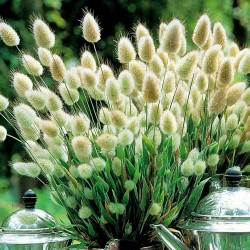
Hare's-tail Grass,...
Cena
1,65 €
SKU: UT 15
Seeds Gallery Com,
5/
5
<!DOCTYPE html>
<html>
<head>
<meta http-equiv="Content-Type" content="text/html; charset=UTF-8" />
</head>
<body>
<h2><strong>Hare's-tail Grass, Bunnytail Seeds (Lagurus ovatus)</strong></h2>
<h2><span style="color: #ff0000;"><strong>Price for Package of 10 seeds.</strong></span></h2>
<p><i><b>Lagurus</b></i><span> </span>is a genus of<span> </span>Old World<span> </span>plants in the<span> </span>grass family, native to the<span> </span>Mediterranean Basin<span> </span>and nearby regions, from<span> </span>Azores<span> </span>and the<span> </span>Canary Islands<span> </span>to<span> </span>Crimea<span> </span>and<span> </span>Saudi Arabia. It is also naturalized in<span> </span>Australia,<span> </span>New Zealand,<span> </span>Ireland<span> </span>and<span> </span>Great Britain, and scattered locations in the<span> </span>Americas.<span> </span>The only known species is<span> </span><i><b>Lagurus ovatus</b></i>, commonly called<span> </span><b>hare's-tail</b>,<sup id="cite_ref-BSBI07_4-0" class="reference"></sup><span> </span><b>hare's-tail grass</b><span> </span>or<span> </span><b>bunnytail</b>.<sup id="cite_ref-RHSAZ_5-0" class="reference"></sup><span> </span>It is also grown as an<span> </span>ornamental plant<span> </span>for its attractive flower panicles.<sup id="cite_ref-6" class="reference"></sup></p>
<h2><span class="mw-headline" id="Description">Description</span></h2>
<p><i>Lagurus ovatus</i><span> </span>is a clump-forming<span> </span>annual<span> </span>growing to 50 cm (20 in) tall by 30 cm (12 in) tall, with pale green grassy foliage and numerous short, oval green flowerheads, turning to a buff colour as they ripen, all summer long.<sup id="cite_ref-RHSAZ_5-1" class="reference"></sup><sup id="cite_ref-8" class="reference"></sup></p>
<div class="thumb tright">
<div class="thumbinner"><img alt="" src="https://upload.wikimedia.org/wikipedia/commons/thumb/5/5c/SeedsLagurus_ovatus.jpg/220px-SeedsLagurus_ovatus.jpg" width="220" height="267" class="thumbimage" />
<div class="thumbcaption">
<div class="magnify"></div>
Seeds</div>
</div>
</div>
<h2><span class="mw-headline" id="Diagnostic_features">Diagnostic features</span></h2>
<ul>
<li>Awns<span> </span>are 8–20 mm</li>
<li>Leaves<span> </span>and sheaths are softly pubescent</li>
<li>Panicle<span> </span>measure 1–7 × 0.5–2 cm</li>
<li>Spikelets<span> </span>are 7–10 mm</li>
<li>Stems<span> </span>grow erect, up to 60 cm</li>
<li>Chromosome number<span> </span>is (2<i>n</i>=14)</li>
</ul>
<h2><span class="mw-headline" id="Distribution">Distribution</span></h2>
<p>Native to the<span> </span>Mediterranean<span> </span>and introduced into<span> </span>Britain, it is now thriving on sandy stretches in the islands of<span> </span>Guernsey<span> </span>and<span> </span>Jersey, occasionally found in<span> </span>Ireland<span> </span>and<span> </span>South Wales. It has become<span> </span>naturalized<span> </span>in County Wexford, Ireland, South Devon and West Sussex.<sup id="cite_ref-9" class="reference"></sup></p>
<p>This plant is known or likely to be<span> </span>susceptible<span> </span>to<span> </span>barley mild mosaic bymovirus.</p>
</body>
</html>
UT 15

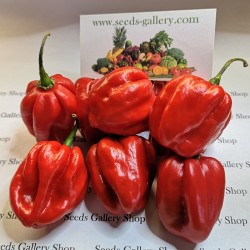
100 Seeds Habanero Red
Cena
5,45 €
SKU: C 19 R
Seeds Gallery Com,
5/
5
<h2>100 Seeds Habanero Red (Capsicum chinense)</h2>
<h2><span style="color:#ff0000;">Price for Package of 100 seeds.</span></h2>
<div>The habanero is a variety of chili pepper. Unripe habaneros are green, and they color as they mature. The most common color variants are orange and red, but the fruit may also be white, brown, yellow, green, or purple. Typically, a ripe habanero chili is 2–6 cm (0.8–2.4 in) long. Habanero chilis are very hot, rated 100,000–650,000 on the Scoville scale. The habanero's heat, its flavor, and its floral aroma have made it a popular ingredient in hot sauces and spicy foods.<br /><br />The name indicates something or someone from La Habana (Havana). In English, it is sometimes spelled and pronounced habañero, the tilde being added as a hyperforeignism patterned after jalapeño.<br /><br /><strong>Origin and current use</strong><br />The habanero chili comes from the Amazon, from which it was spread, reaching Mexico. A specimen of a domesticated habanero plant, dated at 8,500 years old, was found at an archaeological site in Peru.[citation needed] An intact fruit of a small domesticated habanero, found in pre-ceramic levels in Guitarrero Cave in the Peruvian highlands, was dated to 6500 BC.<br /><br />The habanero chili was disseminated by Spanish colonists to other areas of the world, to the point that 18th-century taxonomists mistook China for its place of origin and called it Capsicum chinense ("the Chinese pepper").<br /><br />Today, the largest producer is the Yucatán Peninsula, in Mexico. Habaneros are an integral part of Yucatecan food, accompanying most dishes, either in natural form or purée or salsa. Other modern producers include Belize, Panama, Costa Rica, Colombia, Ecuador, and parts of the United States, including Texas, Idaho, and California.<br /><br />The Scotch bonnet is often compared to the habanero, since they are two varieties of the same species, but they have different pod types. Both the Scotch bonnet and the habanero have thin, waxy flesh. They have a similar heat level and flavor. Both varieties average around the same level of pungency, but the actual degree varies greatly from one fruit to another according to genetics, growing methods, climate, and plant stress.<br /><br />In 1999, the habanero was listed by Guinness World Records as the world's hottest chili, but it has since been displaced by other peppers. The Bhut jolokia (or ghost pepper) and Trinidad moruga scorpion have since been identified as native Capsicum chinense subspecies even hotter than the habanero. Breeders constantly crossbreed subspecies to attempt to create cultivars that will break the record on the Scoville scale. One example is the Carolina Reaper, a cross between a Bhut jolokia pepper with a particularly pungent red habanero.<br /><br /><strong>Cultivation</strong><br />Habaneros thrive in hot weather. Like all peppers, the habanero does well in an area with good morning sun and in soil with a pH level around 5 to 6 (slightly acidic). Habaneros which are watered daily produce more vegetative growth but the same number of fruit, with lower concentrations of capsaicin, as compared to plants which are watered only when dry (every seven days). Overly moist soil and roots will produce bitter-tasting peppers. Daily watering during flowering and early setting of fruit helps prevent flower and immature fruit from dropping, but flower dropping rates are reported to often reach 90% even in ideal conditions.<br /><br />The habanero is a perennial flowering plant, meaning that with proper care and growing conditions, it can produce flowers (and thus fruit) for many years. Habanero bushes are good candidates for a container garden. In temperate climates, though, it is treated as an annual, dying each winter and being replaced the next spring. In tropical and subtropical regions, the habanero, like other chiles, will produce year round. As long as conditions are favorable, the plant will set fruit continuously.<br /><br /><strong>Cultivars</strong><br />Several growers have attempted to selectively breed habanero plants to produce hotter, heavier, and larger peppers. Most habaneros rate between 200,000 and 300,000 on the Scoville scale. In 2004, researchers in Texas created a mild version of the habanero, but retained the traditional aroma and flavor. The milder version was obtained by crossing the Yucatán habanero pepper with a heatless habanero from Bolivia over several generations.</div>
<div></div>
<div>Black habanero is an alternative name often used to describe the dark brown variety of habanero chilis (although they are slightly different, being slightly smaller and slightly more sphere-shaped). Some seeds have been found which are thought to be over 7,000 years old. The black habanero has an exotic and unusual taste, and is hotter than a regular habanero with a rating between 400,000 and 450,000 Scoville units. Small slivers used in cooking can have a dramatic effect on the overall dish. Black habaneros take considerably longer to grow than other habanero chili varieties. In a dried form, they can be preserved for long periods of time, and can be reconstituted in water then added to sauce mixes. Previously known as habanero negro, or by their Nahuatl name, their name was translated into English by spice traders in the 19th century as "black habanero". The word "chocolate" was derived from the Nahuatl word, xocolātl [ʃoˈkolaːt͡ɬ], and was used in the description, as well (as "chocolate habanero"), but it proved to be unpronounceable to the British traders, so it was simply named "black habanero".<br /><br />A 'Caribbean Red,' a cultivar within the habanero family, has a citrusy and slightly smoky flavor, with a Scoville rating ranging from 300,000 to 445,000 Scoville units.</div>
C 19 R (100 S)


This plant is resistant to winter and frost.
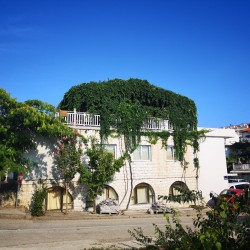
Common Ivy, English Ivy,...
Cena
2,15 €
SKU: MHS 102
Seeds Gallery Com,
5/
5
<!DOCTYPE html>
<html>
<head>
<meta http-equiv="Content-Type" content="text/html; charset=UTF-8" />
</head>
<body>
<h2><span style="font-size: 14pt;"><strong>Common Ivy, English Ivy, European Ivy Seeds (Hedera helix)</strong></span></h2>
<h2><span style="color: #fb0707; font-size: 14pt;"><strong>Price for Package of 10 seeds. </strong></span></h2>
<p><span>Hedera helix (common ivy, English ivy, European ivy, or just ivy) is a species of flowering plant in the family Araliaceae, native to most of Europe and western Asia. A rampant, clinging evergreen vine, it is a familiar sight in gardens, waste spaces, on house walls, tree trunks and in wild areas across its native habitat.</span></p>
<p><span>It is labeled as an invasive species in a number of areas where it has been introduced, particularly Washington, where it is labeled as a noxious weed, many parts of the eastern United States, and Oregon, where its sale or cultivation are banned.</span></p>
<p><span>Hedera helix is an evergreen climbing plant, growing to 20–30 m (66–98 ft) high where suitable surfaces (trees, cliffs, walls) are available, and also growing as groundcover where no vertical surfaces occur. It climbs by means of aerial rootlets with matted pads which cling strongly to the substrate. The ability to climb on surfaces varies with the plants variety and other factors: Hedera helix prefers non-reflective, darker and rough surfaces with near-neutral pH. It generally thrives in a wide range of soil pH with 6.5 being ideal, prefers moist, shady locations and avoids exposure to direct sunlight, the latter promoting drying out in winter.</span></p>
<p><span>The leaves are alternate, 50–100 mm (2–4 in) long, with a 15–20 mm (0.6–0.8 in) petiole; they are of two types, with palmately five-lobed juvenile leaves on creeping and climbing stems, and unlobed cordate adult leaves on fertile flowering stems exposed to full sun, usually high in the crowns of trees or the top of rock faces.</span></p>
<p><span>The flowers are produced from late summer until late autumn, individually small, in 3-to-5 cm-diameter (1.2-to-2.0 in) umbels, greenish-yellow, and very rich in nectar, an important late autumn food source for bees and other insects.</span></p>
<p><span>The fruit are purple-black to orange-yellow berries 6–8 mm (0.2–0.3 in) in diameter, ripening in late winter,[5] and are an important food for many birds, though somewhat poisonous to humans.</span></p>
<p><span>One to five seeds are in each berry, which are dispersed after being eaten by birds.</span></p>
<p><strong><span>The three subspecies are:</span></strong></p>
<p><span>H. h. helix</span></p>
<p><span>central, northern and western Europe, plants without rhizomes, purple-black ripe fruit</span></p>
<p>H. h. poetarum Nyman (syn. <span>Hedera chrysocarpa Walsh)</span></p>
<p><span>southeast Europe and southwest Asia (Italy, Balkans, Turkey), plants without rhizomes, orange-yellow ripe fruit</span></p>
<p><span>H. h. rhizomatifera McAllister</span></p>
<p><span>southeast Spain, plants rhizomatous, purple-black ripe fruit</span></p>
<p><span>The closely related species Hedera canariensis and Hedera hibernica are also often treated as subspecies of H. helix,[8][10] though they differ in chromosome number so do not hybridise readily.[7] H. helix can be best distinguished by the shape and colour of its leaf trichomes, usually smaller and slightly more deeply lobed leaves and somewhat less vigorous growth, though identification is often not easy.</span></p>
<p><strong><span>Range</span></strong></p>
<p><span>It ranges from Ireland northeast to southern Scandinavia, south to Portugal, and east to Ukraine and Iran and northern Turkey.</span></p>
<p><span>The northern and eastern limits are at about the −2 °C (28 °F) winter isotherm, while to the west and southwest, it is replaced by other species of ivy. <strong>Hedera helix itself is much more winter-hardy and survives temperatures of −23.3 °C (−9.9 °F) (USDA Zone 6a) and above.</strong></span></p>
<p><strong><span>Cultivation and uses</span></strong></p>
<p><span>The ivy is widely cultivated as an ornamental plant. Within its native range, the species is greatly valued for attracting wildlife. The flowers are visited by over 70 species of nectar-feeding insects, and the berries eaten by at least 16 species of birds. The foliage provides dense evergreen shelter, and is also browsed by deer.</span></p>
<p><span>In Europe, it is frequently planted to cover walls and the government recommends growing it on buildings for its ability to cool the interior in summer, while providing insulation in winter, as well as protecting the covered building from soil moisture, temperature fluctuations and direct exposure to heavy weather. Further uses include weed suppression in plantings, beautifying unsightly facades and providing additional green by growing on tree trunks.</span></p>
<p><span>Over 30 cultivars have been selected for such traits as yellow, white, variegated (e.g. 'Glacier'), and/or deeply lobed leaves (e.g. 'Sagittifolia'), purple stems, and slow, dwarfed growth.</span></p>
<p><strong><span>Ethnomedical uses</span></strong></p>
<p><span>Ivy extracts are part of current cough medicines. In the past, the leaves and berries were taken orally as an expectorant to treat cough and bronchitis. In 1597, the British herbalist John Gerard recommended water infused with ivy leaves as a wash for sore or watering eyes.[30] The leaves can cause severe contact dermatitis in some people. People who have this allergy (strictly a type IV hypersensitivity) are also likely to react to carrots and other members of the Apiaceae as they contain the same allergen, falcarinol.</span></p>
<p><strong><span>Use as building facade green</span></strong></p>
<p><span>As with any self-climbing facade green, some care is required to make best use of the positive effects: Ivy covering the walls of an old building is a familiar and often attractive sight. It has insulating as well as weather protection benefits, dries the soil and prevents wet walls, but can be problematic if not managed correctly.</span></p>
<p><span>Ivy, and especially European ivy (H. helix) grows vigorously and clings by means of fibrous roots, which develop along the entire length of the stems. These are difficult to remove, leaving an unsightly "footprint" on walls, and possibly resulting in expensive resurfacing work. Additionally, ivy can quickly invade gutters and roofspaces, lifting tiles and causing blockages. It also harbors mice and other unwelcome creatures. The plants have to be cut off at the base, and the stumps dug out or killed to prevent regrowth.</span></p>
<p><span>Therefore, if a green facade is desired, this decision has to be made consciously, since later removal would be tedious.</span></p>
</body>
</html>
MHS 102

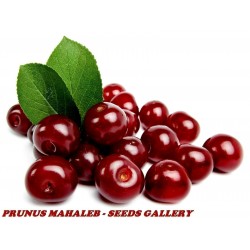
Mahaleb Cherry, St Lucie...
Cena
1,95 €
SKU: V 219
Seeds Gallery Com,
5/
5
<h2><strong>Mahaleb Cherry, St Lucie Cherry Seeds (Prunus mahaleb)</strong></h2>
<h2><span style="color: #ff0000;"><strong>Price for Package of 10 seeds.</strong></span></h2>
<p>Prunus mahaleb, the mahaleb cherry or St Lucie cherry, is a species of cherry tree. The tree is cultivated for a spice obtained from the seeds inside the cherry stones. The seeds have a fragrant smell and have a taste comparable to bitter almonds with cherry notes.</p>
<p>The tree is native in the Mediterranean region, Iran and parts of central Asia. It is adjudged to be native in northwestern Europe or at least it is naturalized there. It is a deciduous tree or large shrub, growing to 2–10 m (rarely up to 12 m) tall with a trunk up to 40 cm diameter.</p>
<p><strong>Description and ecology</strong></p>
<p>The tree's bark is grey-brown, with conspicuous lenticels on young stems, and shallowly fissured on old trunks. The leaves are 1.5-5 cm long, 1-4 cm. wide, alternate, clustered at the end of alternately arranged twigs, ovate to cordate, pointed, have serrate edges, longitudinal venation and are glabrous and green. The petiole is 5-20 mm, and may or may not have two glands. The flowers are fragrant, pure white, small, 8-20 mm diameter, with an 8-15 mm pedicel; they are arranged 3-10 together on a 3-4 cm long raceme. The flower pollination is mainly by bees. The fruit is a small thin-fleshed cherry-like drupe 8–10 mm in diameter, green at first, turning red then dark purple to black when mature, with a very bitter flavour; flowering is in mid spring with the fruit ripening in mid to late summer.</p>
<p>Prunus mahaleb occurs in thickets and open woodland on dry slopes; in central Europe at altitudes up to 1,700 m, and in highlands at 1,200-2,000 m in southern Europe.[8] It has become naturalised in some temperate areas, including Europe north of its native range (north to Great Britain and Sweden), and locally in Australia and the United States.</p>
<p>It demonstrates selective fruit abortion, producing a high proportion of excess flowers that result in low fruit set levels. This reduces the number of "poor quality" fruit and increases the viability of its seeds.</p>
<p>A scientific study[13] discovered an ecological dependence between the plant and four species of frugivorous birds in southeastern Spain; blackbirds and blackcaps proved to be the most important seed dispersers. When Prunus mahaleb is fruiting, these birds consume the fruit almost exclusively, and disperse the seeds to the locations favourable for the tree's growth. The way in which some birds consume the fruits and the habitats those birds use may act as a selective force in determining which genetic variations of the cherry flourish.</p>
<p><strong>Cultivation and uses</strong></p>
<p>The plant is cultivated for a spice obtained from the seeds inside the cherry stones. It is fragrant and has the taste of bitter almonds. It is used in small quantities to sharpen sweet foods, such as the Turkish sweet-bread çörek (chorak), the Greek sweet-bread tsoureki or the Armenian sweet-bread chorak. The chemical constituents are still uncertain, but the spice is prepared from the seeds, either by grinding and powdering the seed kernels, or in oil extracted from the seeds.</p>
<p>The wood is hard, and is used in cabinet-making and for pipes.</p>
<p>The bark, wood, and seeds contain coumarin. They have anti-inflammatory, sedative and vasodilation effects.</p>
<p>Away from its native range, the species is grown as an ornamental tree for its strongly fragrant flowers, throughout temperate regions of the world. A number of cultivars have been selected for their ornamental value, including 'Albomarginata', with variegated foliage, 'Bommii', a dwarf with strongly pendulous branches, 'Globosa', a compact dwarf clone, 'Pendula', with drooping branching, and 'Xanthocarpa' with yellow fruit.</p>
<p><strong>Early history of mahaleb in human use</strong></p>
<p>Prunus mahaleb is a likely candidate for the ḫalub-tree mentioned in early Sumerian writings, a durable fruit-bearing hardwood with seeds and leaves known for their medicinal properties and associated with the goddess Inana.[19] The Arabic محلب mahleb or mahlab meaning the mahaleb cherry is in medieval Arabic writings by among others Al-Razi (died 930), Ibn al-Baitar (died 1248) and Ibn al-Awwam.[20] Ibn Al-Awwam in his book on agriculture dated late 12th century described how to cultivate the mahaleb tree: he says the tree is a vigorous grower, easy to grow, but a thing to watch out for is that it is not resistant to prolonged drought. He also described how to prepare the mahaleb seeds by boiling them in sugared water.[21] The word, and probably the mahaleb itself, does not appear in classical Latin, nor early or mid medieval Latin, and is rare in late medieval Latin. One early record in Latin is year 1317 in an encyclopedia by Matthaeus Silvaticus who wrote that the "mahaleb" is the kernel seed of the fruit of both domesticated and wild cherry trees in Arabic countries.[22] Another early record in Latin is in a medical-botany book by Ioannis Mesuae in 1479 spelled almahaleb (where "al-" is the Arabic definite article).[23] In 1593 the Latin botanist Carolus Clusius spelled it mahaleb.[23] Today its cultivation and use is largely restricted to the region that in the 19th and earlier centuries formed the Ottoman Empire. Syria is the main exporting country.</p>
<p> </p>
V 219 (10 S)

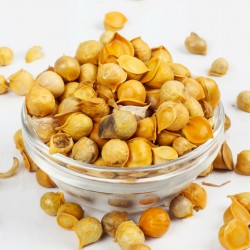
Semena česneku kašmírského...
Cena
2,85 €
SKU: P 387
Seeds Gallery Com,
5/
5
<!DOCTYPE html>
<html>
<head>
<meta http-equiv="Content-Type" content="text/html; charset=UTF-8" />
</head>
<body>
<h2><span><strong>Semena česneku kašmírského (Allium schoenoprasum)</strong> </span></h2>
<h2><span style="color: #ff0000;"><strong>Cena je za balení 3 česneku.</strong> </span></h2>
<p>Kašmírský česnek má tvrdou, zlatohnědou slupku a vypadá jako jednotlivý stroužek česneku. Má zaoblený baňatý tvar s tuhou zploštělou částí na jedné straně, která se blíží k bodu na konci konce hřebíčku. Malý jediný hřebíček má průměr 1,5 až 4 centimetry. Vytvrzené vnější vrstvy tvoří ochrannou slupku pro cibuli, zatímco se vyvíjí při teplotách pod nulou. Hřebíček dole má jasně bílou až krémově bílou barvu a nabízí silnou, štiplavou česnekovou příchuť bez kyselosti přítomné v jiných odrůdách.</p>
<p>Kašmírský česnek, také známý v Indii jako himálajský nebo džammu česnek, je vzácná odrůda Allium sativum s jedním stroužkem. Známý jako česnek Snow Mountain a Ek Pothi Lahsun v hindštině, se sklízí pouze jednou ročně z vysokých nadmořských výšek Himalájí a je známý po celé Indii pro své přínosy pro zdraví. Výzkum ukázal, že kašmírský česnek je sedmkrát účinnější než komerční česnek, pokud jde o užitečné sloučeniny a vlastnosti.</p>
<p>Kašmírský česnek pochází z himálajských hor, v dnešním Džammú a Kašmíru. Tento region je mezi zeměmi Pákistán na západě a Tibetem a Čínou na východě a je nejsevernějším státem v Indii. Kašmírský česnek se pěstuje v nadmořské výšce 1 800 metrů v klimatu s extrémně nízkou hladinou kyslíku a drsnými, zasněženými podmínkami. Je to jedna z mála rostlin, která přežije chladné vysokohorské prostředí. Česnek pochází z této oblasti, v dnešním Kyrgyzstánu, Tádžikistánu, Turkmenistánu a Uzbekistánu. Kašmírský česnek je považován za jednu z nejčistších odrůd kvůli regionu, kde se pěstuje, a nedostatku průmyslových znečišťujících látek v půdě.</p>
</body>
</html>
P 387

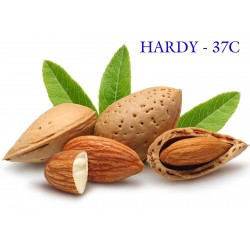
Sweet Almond Seeds (Prunus...
Cena
2,55 €
SKU: V 211
Seeds Gallery Com,
5/
5
<!DOCTYPE html>
<html>
<head>
<meta http-equiv="Content-Type" content="text/html; charset=UTF-8" />
</head>
<body>
<h2><strong>Sweet Almond Seeds (Prunus amygdalus)</strong></h2>
<h2><span style="color: #ff0000;"><strong>Price for Package of 5 seeds.</strong></span></h2>
<p>The almond (Prunus dulcis, syn. Prunus amygdalus) is a species of tree native to the Middle East, the Indian subcontinent and North Africa.</p>
<p>"Almond" is also the name of the edible and widely cultivated seed of this tree. Within the genus Prunus, it is classified with the peach in the subgenus Amygdalus, distinguished from the other subgenera by corrugations on the shell (endocarp) surrounding the seed.</p>
<p>The fruit of the almond is a drupe, consisting of an outer hull and a hard shell with the seed, which is not a true nut, inside. Shelling almonds refers to removing the shell to reveal the seed. Almonds are sold shelled or unshelled. Blanched almonds are shelled almonds that have been treated with hot water to soften the seedcoat, which is then removed to reveal the white embryo.</p>
<p>The almond is a deciduous tree, growing 4–10 m (13–33 ft) in height, with a trunk of up to 30 cm (12 in) in diameter. The young twigs are green at first, becoming purplish where exposed to sunlight, then grey in their second year. The leaves are 3–5 inches long,[3] with a serrated margin and a 2.5 cm (1 in) petiole. The flowers are white to pale pink, 3–5 cm (1–2 in) diameter with five petals, produced singly or in pairs and appearing before the leaves in early spring.[4][5] Almond grows best in Mediterranean climates with warm, dry summers and mild, wet winters. The optimal temperature for their growth is between 15 and 30 °C (59 and 86 °F) and the tree buds have a chilling requirement of 300 to 600 hours below 7.2 °C (45.0 °F) to break dormancy.</p>
<p>Almonds begin bearing an economic crop in the third year after planting. Trees reach full bearing five to six years after planting. The fruit matures in the autumn, 7–8 months after flowering.</p>
<p><strong>Drupe</strong></p>
<p>The almond fruit measures 3.5–6 cm (1–2 in) long. In botanical terms, it is not a nut but a drupe. The outer covering or exocarp, fleshy in other members of Prunus such as the plum and cherry, is instead a thick, leathery, grey-green coat (with a downy exterior), called the hull. Inside the hull is a reticulated, hard, woody shell (like the outside of a peach pit) called the endocarp. Inside the shell is the edible seed, commonly called a nut. Generally, one seed is present, but occasionally two occur.</p>
<p><strong>Origin and history</strong></p>
<p>The almond is native to the Mediterranean climate region of the Middle East, eastward as far as the Yamuna River in India. It was spread by humans in ancient times along the shores of the Mediterranean into northern Africa and southern Europe, and more recently transported to other parts of the world, notably California, United States.</p>
<p>The wild form of domesticated almond grows in parts of the Levant. The fruit of the wild forms contains the glycoside amygdalin, "which becomes transformed into deadly prussic acid (hydrogen cyanide) after crushing, chewing, or any other injury to the seed."</p>
<p>Selection of the sweet type from the many bitter types in the wild marked the beginning of almond domestication. It is unclear as to which wild ancestor of the almond created the domesticated species. Ladizinsky suggests the taxon Amygdalus fenzliana (Fritsch) Lipsky is the most likely wild ancestor of the almond in part because it is native of Armenia and western Azerbaijan where it was apparently domesticated.</p>
<p>While wild almond species are toxic, domesticated almonds are not; Jared Diamond argues that a common genetic mutation causes an absence of amygdalin, and this mutant was grown by early farmers, "at first unintentionally in the garbage heaps, and later intentionally in their orchards". Zohary and Hopf believe that almonds were one of the earliest domesticated fruit trees due to "the ability of the grower to raise attractive almonds from seed. Thus, in spite of the fact that this plant does not lend itself to propagation from suckers or from cuttings, it could have been domesticated even before the introduction of grafting". Domesticated almonds appear in the Early Bronze Age (3000–2000 BC) such as the archaeological sites of Numeria (Jordan), or possibly a little earlier. Another well-known archaeological example of the almond is the fruit found in Tutankhamun's tomb in Egypt (c. 1325 BC), probably imported from the Levant. Of the European countries that the Royal Botanic Garden Edinburgh reported as cultivating almonds, Germany is the northernmost, though the domesticated form can be found as far north as Iceland.</p>
<p><strong>Etymology and names</strong></p>
<p>The word "almond" comes from Old French almande or alemande, Late Latin *amandula, derived through a form amygdala from the Greek ἀμυγδαλή (amygdalē) (cf. amygdala), an almond.[15] The al- in English, for the a- used in other languages may be due a confusion with the Arabic article al, the word having first dropped the a- as in the Italian form mandorla; the British pronunciation ah-mond and the modern Catalan ametlla and modern French amande show a form of the word closer to the original. Other related names of almond include Mandel or Knackmandel (German), mandorlo (Italian for the tree), mandorla (Italian for the fruit), amêndoa (Portuguese), and almendra (Spanish).[16]</p>
<p>The adjective "amygdaloid" (literally "like an almond") is used to describe objects which are roughly almond-shaped, particularly a shape which is part way between a triangle and an ellipse. See, for example, the brain structure amygdala, which uses a direct borrowing of the Greek term amygdalē.</p>
<p><strong>Production</strong></p>
<p>World production of almonds was 2.9 million tonnes in 2013, with United States as the largest producer of 1.8 million tonnes.</p>
<p>In the United States, production is concentrated in California, with almonds being California's third-leading agricultural product, its top agricultural export in 2008,[19] and 100% of the U.S. commercial supply. The United States is the dominant supplier of almonds. Almonds are mostly exported as shelled almonds (70%), with the remainder being either unshelled or processed.[20] In 2015, environmental problems in California affected the almond supply, contributing to higher almond prices worldwide. Rising demand for almonds has also contributed to higher prices worldwide and increased production in California.</p>
<p>Australia is the largest almond production region in the Southern Hemisphere, and second largest producing country. In 2013, Australia produced 9% of the world almond supply (table). Most of the almond orchards are located along the Murray River corridor in New South Wales, Victoria, and South Australia.</p>
<p>Spain has one of the most diverse commercial cultivars of almonds.[25] It is grown in Spain's Catalonia, Valencia, Murcia, Andalusia, and Aragón regions and the Balearic Islands.[26] In Greece, most of the production comes from the region of Magnesia at the area of Almyros. The most cultivated types of almonds in Greece are 'Ferragnes' and 'Texas' ('Mission'), which are known for their sweet taste and premium quality. Because of its quality, it is used as a luxury nut. In Turkey, most of the production comes from the Aegean, Marmara, and Mediterranean regions.</p>
<p><strong>Pollination</strong></p>
<p>The pollination of California's almonds is the largest annual managed pollination event in the world, with close to one million hives (nearly half of all beehives in the USA) being trucked in February to the almond groves. Much of the pollination is managed by pollination brokers, who contract with migratory beekeepers from at least 49 states for the event. This business has been heavily affected by colony collapse disorder, causing nationwide shortages of honey bees and increasing the price of insect pollination. To partially protect almond growers from the rising cost of insect pollination, researchers at the Agricultural Research Service (ARS) have developed a new line of self-pollinating almond trees.[28] Self-pollinating almond trees, such as the 'Tuono', have been around for a while, but their harvest is not as desirable as the insect-pollinated California 'Nonpareil' almond tree. The 'Nonpareil' tree produces large, smooth almonds and offers 60–65% edible kernel per nut. The 'Tuono' has thicker, hairier shells and offers only 32% of edible kernel per nut, but having a thick shell has advantages. The 'Tuono's' shell protects the nut from threatening pests such as the navel orangeworm. ARS researchers have managed to crossbreed the pest-resistant 'Tuono' tree with the 'Nonpareil', resulting in hybridized cultivars of almond trees that are self-pollinated and maintain a high nut quality.[29] The new, self-pollinating hybrids possess quality skin color, flavor, and oil content, and reduce almond growers' dependency on insect pollination.</p>
<p><strong>Sweet and bitter almonds</strong></p>
<p>The seeds of Prunus dulcis var. dulcis are predominantly sweet[31][32] but some individual trees produce seeds that are somewhat more bitter. The genetic basis for bitterness involves a single gene, the bitter flavour furthermore being recessive,[33][34] both aspects making this trait easier to domesticate. The fruits from Prunus dulcis var. amara are always bitter, as are the kernels from other Prunus species, such as peach and cherry (to a lesser extent).</p>
<p>The bitter almond is slightly broader and shorter than the sweet almond and contains about 50% of the fixed oil that occurs in sweet almonds. It also contains the enzyme emulsin which, in the presence of water, acts on soluble glucosides, amygdalin, and prunasin,[35] yielding glucose, cyanide and the essential oil of bitter almonds, which is nearly pure benzaldehyde, the chemical causing the bitter flavor. Bitter almonds may yield from 4–9 mg of hydrogen cyanide per almond[36] and contain 42 times higher amounts of cyanide than the trace levels found in sweet almonds.[37] The origin of cyanide content in bitter almonds is via the enzymatic hydrolysis of amygdalin.</p>
<p>Extract of bitter almond was once used medicinally but even in small doses, effects are severe or lethal, especially in children; the cyanide must be removed before consumption.[37] The acute oral lethal dose of cyanide for adult humans is reported to be 0.5–3.5 mg/kg of body weight (approximately 50 bitter almonds), whereas for children, consuming 5–10 bitter almonds may be fatal.</p>
<p>All commercially grown almonds sold as food in the United States are "sweet" cultivars. The US Food and Drug Administration reported in 2010 that some fractions of imported sweet almonds were contaminated with bitter almonds. Eating such almonds could result in vertigo and other typical bitter almond (cyanide) poisoning effects.</p>
<p>Certain natural food stores sell "bitter almonds" or "apricot kernels" labeled as such, requiring significant caution by consumers for how to prepare and eat these products.</p>
<p><strong>Culinary uses</strong></p>
<p>While the almond is often eaten on its own, raw or toasted, it is also a component of various dishes. Almonds are available in many forms, such as whole, sliced (flaked, slivered), and as flour. Almonds yield almond oil and can also be made into almond butter or almond milk. These products can be used in both sweet and savoury dishes.</p>
<p>Along with other nuts, almonds can be sprinkled over breakfasts and desserts, particularly muesli or ice cream-based dishes. Almonds are used in marzipan, nougat, many pastries (including jesuites), cookies (including French macarons, macaroons), and cakes (including financiers), noghl, and other sweets and desserts. They are also used to make almond butter, a spread similar to peanut butter, popular with peanut allergy sufferers and for its naturally sweeter taste. The young, developing fruit of the almond tree can be eaten whole ("green almonds") when they are still green and fleshy on the outside and the inner shell has not yet hardened. The fruit is somewhat sour, but is a popular snack in parts of the Middle East, eaten dipped in salt to balance the sour taste. Also in the Middle East they are often eaten with dates. They are available only from mid-April to mid-June in the Northern Hemisphere; pickling or brining extends the fruit's shelf life.</p>
<p>Almond cookies, Chinese almond biscuits, and Italian ricciarelli are made with almonds.</p>
<p>In Greece, ground blanched almonds are used as the base material in a great variety of desserts, usually called amygdalota (αμυγδαλωτά). Because of their white colour, most are traditionally considered "wedding sweets" and are served at wedding banquets. In addition, a soft drink known as soumada is made from almonds in various regions.</p>
<p>In Iran, green almonds are dipped in sea salt and eaten as snacks on street markets; they are called chaqale bâdam. Also sweet almonds are used to prepare a special food for babies, named harire badam. Almonds are added to some foods, cookies, and desserts, or are used to decorate foods. People in Iran consume roasted nuts for special events, for example, during New Year (Nowruz) parties.</p>
<p>In Italy, the bitter almonds from apricots are the base for amaretti[40][41] (almond macaroons), a common dessert. Traditionally, a low percentage of bitter almonds (10–20%) is added to the ingredients, which gives the cookies their bitter taste (commercially, apricot kernels are used as a substitute for bitter almonds). Almonds are also a common choice as the nuts to include in torrone. In Apulia and Sicily, pasta di mandorle (almond paste) is used to make small soft cakes, often decorated with jam, pistachio, or chocolate. In Sicily, almond milk is a popular refreshing beverage in summer.</p>
<p>In Morocco, almonds in the form of sweet almond paste are the main ingredient in pastry fillings, and several other desserts. Fried blanched whole almonds are also used to decorate sweet tajines such as lamb with prunes. A drink made from almonds mixed with milk is served in important ceremonies such as weddings and can also be ordered in some cafes. Southwestern Berber regions of Essaouira and Souss are also known for amlou, a spread made of almond paste, argan oil, and honey. Almond paste is also mixed with toasted flour and among others, honey, olive oil or butter, anise, fennel, sesame seeds, and cinnamon to make sellou (also called zamita in Meknes or slilou in Marrakech), a sweet snack known for its long shelf life and high nutritive value.</p>
<p>In Indian cuisine, almonds are the base ingredients of pasanda-style and Mughlai curries. Badam halva is a sweet made from almonds with added coloring. Almond flakes are added to many sweets (such as sohan barfi), and are usually visible sticking to the outer surface. Almonds form the base of various drinks which are supposed to have cooling properties. Almond sherbet or sherbet-e-badaam, is a popular summer drink. Almonds are also sold as a snack with added salt.</p>
<p>In Israel almonds are topping tahini cookie or eaten as a snack.</p>
<p>The 'Marcona' almond cultivar is recognizably different from other almonds, and is marketed by name.[42] The kernel is short, round, relatively sweet, and delicate in texture. It has been grown in Spain for a long time and its origin is unknown; the tree is very productive, and the shell of the nut is very hard.[42] 'Marcona' almonds are traditionally served after being lightly fried in oil, and are used by Spanish confectioners to prepare a sweet called turrón.</p>
<p><strong>Almond milk</strong></p>
<p>Almonds can be processed into a milk substitute called almond milk; the nut's soft texture, mild flavour, and light colouring (when skinned) make for an efficient analog to dairy, and a soy-free choice for lactose intolerant people and vegans. Raw, blanched, and lightly toasted almonds work well for different production techniques, some of which are similar to that of soymilk and some of which use no heat, resulting in "raw milk" (see raw foodism).</p>
<p><strong>Almond flour and skins</strong></p>
<p>Almond flour is often used as a gluten-free alternative to wheat flour in cooking and baking.</p>
<p>Almonds contain polyphenols in their skins consisting of flavonols, flavan-3-ols, hydroxybenzoic acids and flavanones analogous to those of certain fruits and vegetables. These phenolic compounds and almond skin prebiotic dietary fiber have commercial interest as food additives or dietary supplements.</p>
<p><strong>Almond syrup</strong></p>
<p>Historically, almond syrup was an emulsion of sweet and bitter almonds, usually made with barley syrup (orgeat syrup) or in a syrup of orange flower water and sugar, often flavored with a synthetic aroma of almonds.</p>
<p>Due to the cyanide found in bitter almonds, modern syrups generally are produced only from sweet almonds. Such syrup products do not contain significant levels of hydrocyanic acid, so are generally considered safe for human consumption</p>
<p><strong>Nutrition</strong></p>
<p>The almond is a nutritionally dense food (see chart pictured right) and a 100 gram serving is a rich source (>20% of the Daily value, DV) of the B vitamins riboflavin and niacin, vitamin E, and the essential minerals calcium, iron, magnesium, manganese, phosphorus, and zinc. The same serving size is also a good source (10–19% DV) of the B vitamins thiamine, vitamin B6, and folate; choline; and the essential mineral potassium. They are also rich in dietary fiber, monounsaturated fats, and polyunsaturated fats, fats which potentially may lower LDL cholesterol.[46] Typical of nuts and seeds, almonds also contain phytosterols such as beta-sitosterol, stigmasterol, campesterol, sitostanol, and campestanol, which have been associated with cholesterol-lowering properties.</p>
<p>Preliminary research associates consumption of almonds with elevated blood levels of high density lipoproteins and lower low density lipoproteins.</p>
<p>Almonds may cause allergy or intolerance. Cross-reactivity is common with peach allergens (lipid transfer proteins) and tree nut allergens. Symptoms range from local signs and symptoms (e.g., oral allergy syndrome, contact urticaria) to systemic signs and symptoms including anaphylaxis (e.g., urticaria, angioedema, gastrointestinal and respiratory symptoms).</p>
<p>During the digestion process in humans, almond flour may be fermented into short-chain fatty acids, most notably butyrate which is a substrate for cells lining the large intestine.</p>
<p><strong>Oils</strong></p>
<p>Almonds are a rich source of oil, with 50% of kernel dry mass as fat (table). Almond oil contains 32% monounsaturated oleic acid (an omega-9 fatty acid), 13% linoleic acid (a polyunsaturated omega-6 essential fatty acid), and 5% saturated fatty acid (USDA link in table). Linolenic acid, an polyunsaturated omega-3 fat, is not present (table). Almond oil is a rich source of vitamin E providing 261% of the Daily Value per 100 ml (table).</p>
<p>"Oleum amygdalae", the fixed oil, is prepared from either sweet or bitter almonds and is a glyceryl oleate, with a slight odour and a nutty taste. It is almost insoluble in alcohol but readily soluble in chloroform or ether. Sweet almond oil is obtained from the dried kernel of sweet almonds.</p>
<p>The oil is good for application to the skin as an emollient, and has been traditionally used by massage therapists to lubricate the skin during a massage session.</p>
<p>Almond oil can also be used as a wood conditioner of certain woodwind instruments, such as the oboe and clarinet.</p>
<p><strong>Aflatoxins</strong></p>
<p>Almonds are susceptible to aflatoxin-producing molds.[53] Aflatoxins are potent carcinogenic chemicals produced by molds such as Aspergillus flavus and Aspergillus parasiticus. The mold contamination may occur from soil, previously infested almonds, and almond pests such as navel-orange worm. High levels of mold growth typically appear as gray to black filament like growth. It is unsafe to eat mold infected tree nuts.</p>
<p>Some countries have strict limits on allowable levels of aflatoxin contamination of almonds and require adequate testing before the nuts can be marketed to their citizens. The European Union, for example, introduced a requirement since 2007 that all almond shipments to EU be tested for aflatoxin. If aflatoxin does not meet the strict safety regulations, the entire consignment may be reprocessed to eliminate the aflatoxin or it must be destroyed.</p>
<p> </p>
</body>
</html>
V 211 N


Odrůda z Ameriky
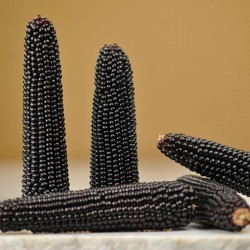
Black Popcorn Corn Dakota...
Cena
2,15 €
SKU: VE 127 (1.1g)
Seeds Gallery Com,
5/
5
<h2><strong>Black Popcorn Corn Dakota Seeds</strong></h2>
<h2><span style="color: #ff0000;" class=""><strong>Price for Package of 9-15 (1,1g) seeds. </strong></span></h2>
<p>One of the earliest maturing corns and easiest to grow. 150 cm high plants. Dark black kernels have a ruby-red, glassy shine when held in the right angle of light. The pointy kernels pop bright white with a small black hull still attached. The flavor is delicious, hearty and crunchy. Many popcorns lack this richness, which gives Dakota Black the ability to act as a meal all by itself. Easy to grow, fruits ripening after 90 - 105 days.</p>
<p>Location: sun, half shadow</p>
<p>Life form: annual</p>
<p>Height: 150 cm (60 in)</p><script src="//cdn.public.n1ed.com/G3OMDFLT/widgets.js"></script>
VE 127 (1.1g)


Tato rostlina má obrovské plody
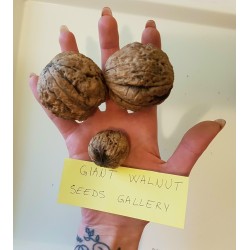
GIANT WALNUT Seeds (Juglans...
Cena
15,00 €
SKU: V 206
Seeds Gallery Com,
5/
5
<!DOCTYPE html>
<html>
<head>
<meta http-equiv="Content-Type" content="text/html; charset=UTF-8" />
</head>
<body>
<h2><strong>GIANT WALNUT Seeds (Juglans regia)</strong></h2>
<h2><span style="color: #ff0000;"><strong>Price for Package of 1 seeds.</strong></span></h2>
<p><strong>This walnut is 3 - 4 times bigger than any other!!!</strong> </p>
<p>A walnut is the nut of any tree of the genus Juglans (Family Juglandaceae), particularly the Persian or English walnut, Juglans regia. Technically a walnut is the seed of a drupe or drupaceous nut, and thus not a true botanical nut. It is used for food after being processed while green for pickled walnuts or after full ripening for its nutmeat. Nutmeat of the eastern black walnut from the Juglans nigra is less commercially available, as are butternut nutmeats from Juglans cinerea. The walnut is nutrient-dense with protein and essential fatty acids.</p>
<p>Walnuts are rounded, single-seeded stone fruits of the walnut tree commonly used for the meat after fully ripening. Following full ripening, the removal of the husk reveals the wrinkly walnut shell, which is usually commercially found in two segments (three-segment shells can also form). During the ripening process, the husk will become brittle and the shell hard. The shell encloses the kernel or meat, which is usually made up of two halves separated by a partition. The seed kernels – commonly available as shelled walnuts – are enclosed in a brown seed coat which contains antioxidants. The antioxidants protect the oil-rich seed from atmospheric oxygen, thereby preventing rancidity.</p>
<p>Walnuts are late to grow leaves, typically not until more than halfway through the spring. They secrete chemicals into the soil to prevent competing vegetation from growing. Because of this, flowers or vegetable gardens should not be planted close to them.</p>
<p><strong>Food use</strong></p>
<p>Walnut meats are available in two forms; in their shells or shelled. The meats can be as large as halves or any smaller portions that may happen during processing, candied or as an ingredient in other foodstuffs. Pickled walnuts that are the whole fruit can be savory or sweet depending on the preserving solution. Walnut butters can be homemade or purchased in both raw and roasted forms. All walnuts can be eaten on their own (raw, toasted or pickled) or as part of a mix such as muesli, or as an ingredient of a dish. For example, walnut pie is prepared using walnuts as a main ingredient. Walnut Whip, coffee and walnut cake, and pickled walnuts are more examples. Walnuts are also popular in brownie recipes and as ice cream toppings.</p>
<p>Walnut oil is available commercially and is chiefly used as a food ingredient particularly in salad dressings. It has a low smoke point, which limits its use for frying.</p>
<p>Walnut is the main ingredient of Fesenjan, a khoresh (stew) in Iranian cuisine.</p>
<p><strong>Nutritional value</strong></p>
<p>Walnuts without shells are 4% water, 15% protein, 65% fat, and 14% carbohydrates, including 7% dietary fiber (table).</p>
<p>In a 100 gram serving, walnuts provide 2,740 kilojoules (654 kcal) and rich content (more than 19% of the Daily Value or DV) of several dietary minerals, particularly manganese at 163% DV, and B vitamins (table).</p>
<p>While English walnuts are the most commonly consumed, their nutrient density and profile are generally similar to those of black walnuts.</p>
<p>Unlike most nuts that are high in monounsaturated fatty acids, walnut oil is composed largely of polyunsaturated fatty acids (72% of total fats), particularly alpha-linolenic acid (14%) and linoleic acid (58%), although it does contain oleic acid as 13% of total fats.</p>
<p><strong>Health claims</strong></p>
<p>Having evaluated the scientific literature on the potential health value of consuming walnuts, the US Food and Drug Administration (FDA) provided guidance described as a Qualified Health Claim to manufacturers for labeling of food and dietary supplement products, stating: "Supportive but not conclusive research shows that eating 1.5 ounces per day of walnuts, as part of a low saturated fat and low cholesterol diet and not resulting in increased caloric intake, may reduce the risk of coronary heart disease."</p>
<p>One manufacturer of walnut products received an FDA Warning Letter for making unsubstantiated claims in the prevention, mitigation, and treatment of disease, causing the products to be misbranded as "drugs", and so violating regulations of the Federal Food, Drug, and Cosmetic Act in Title 21 of the US Code of Federal Regulations.</p>
<p><strong>Folk medicine</strong></p>
<p>Walnuts have been listed as one of the 38 substances used to prepare Bach flower remedies,[13] a kind of traditional medicine promoted for its possible effect on health. However, according to Cancer Research UK, "there is no scientific evidence to prove that flower remedies can control, cure or prevent any type of disease, including cancer".</p>
<p><strong>Inks and dyes</strong></p>
<p>The husks of the black walnut Juglans nigra were once used to make an ink for writing and drawing, having been used by artists including Leonardo da Vinci and Rembrandt.</p>
<p>Walnut husk pigments are used as a brown dye for fabric[16] as once applied in classical Rome and medieval Europe for dyeing hair.</p>
<p><strong>Cleaning</strong></p>
<p>The United States Army once used ground walnut shells for the cleaning of aviation parts because of low cost and non-abrasive qualities. However, an investigation of a fatal Boeing CH-47 Chinook helicopter crash (September 11, 1982, in Mannheim, Germany) revealed that walnut grit clogged an oil port, leading to the accident and the discontinuation of walnut shells as a cleaning agent.</p>
<p><strong>Chemical analysis</strong></p>
<p>Walnut hulls contain polyphenols that stain hands and can cause skin irritation. Seven phenolic compounds, including ferulic acid, vanillic acid, coumaric acid, syringic acid, myricetin, juglone, were identified in walnut husks. Juglone, the predominant phenolic, was found in concentrations of 2-4% fresh weight.</p>
<p>Walnuts also contain the ellagitannin pedunculagin.[20] Regiolone has been isolated with juglone, betulinic acid and sitosterol from the stem bark of J. regia.</p>
<p><strong>Uses in Chinese culture</strong></p>
<p>In China, pairs of walnuts have traditionally been rotated and played with in the palm of the hand, both as a means to stimulate blood circulation and as a status symbol. Individual and pairs of large, old, symmetrically shaped, and sometimes intricately carved walnuts are valued highly and have recently been used as an investment, with some of them fetching tens of thousands of dollars.</p>
<p>Pairs of walnuts are sometimes sold in their green husks for a form of gambling known as du he tao.</p>
<p><strong>Types</strong></p>
<p>The two most common major species of walnuts are grown for their seeds – the Persian or English walnut and the black walnut. The English walnut (J. regia) originated in Persia, and the black walnut (J. nigra) is native to eastern North America. The black walnut is of high flavor, but due to its hard shell and poor hulling characteristics it is not grown commercially for nut production. Numerous walnut cultivars have been developed commercially, which are nearly all hybrids of the English walnut.</p>
<p>Other species include J. californica, the California black walnut (often used as a root stock for commercial breeding of J. regia), J. cinerea (butternuts), and J. major, the Arizona walnut. Other sources list J. californica californica as native to southern California, and Juglans californica hindsii, or just J. hindsii, as native to northern California; in at least one case these are given as "geographic variants" instead of subspecies (Botanica).</p>
<p><strong>Production</strong></p>
<p>In 2013, worldwide production of walnuts was 3.458 million tonnes, with China contributing 49% of the world total (table).[3] Other major producers were (in the order of decreasing harvest): Iran, United States, Turkey and Ukraine.</p>
<p>The average worldwide walnut yield was about 3.5 tonnes per hectare in 2013.[3] Eastern European countries had the highest yield, with Slovenia and Romania each harvesting about 22 tonnes per hectare.</p>
<p>The United States is the world's largest exporter of walnuts, followed by Turkey.[4] The Central Valley of California produces 99 percent of United States commercial English walnuts.</p>
<p><strong>Storage</strong></p>
<p>Walnuts, like other tree nuts, must be processed and stored properly. Poor storage makes walnuts susceptible to insect and fungal mold infestations; the latter produces aflatoxin – a potent carcinogen. A mold-infested walnut batch should be entirely discarded.</p>
<p>The ideal temperature for longest possible storage of walnuts is in the −3 to 0 °C (27 to 32 °F) and low humidity – for industrial and home storage. However, such refrigeration technologies are unavailable in developing countries where walnuts are produced in large quantities; there, walnuts are best stored below 25 °C (77 °F) and low humidity. Temperatures above 30 °C (86 °F), and humidities above 70 percent can lead to rapid and high spoilage losses. Above 75 percent humidity threshold, fungal molds that release dangerous aflatoxin can form.</p>
</body>
</html>
V 206

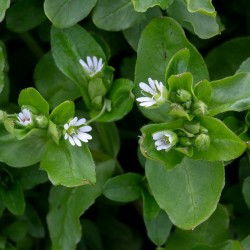
Chickweed Seeds (Stellaria...
Cena
1,95 €
SKU: MHS 81
Seeds Gallery Com,
5/
5
<h2 class=""><strong>Chickweed Seeds (Stellaria Media)</strong></h2>
<h2><span style="color: #ff0000;" class=""><strong>Price for Package of 100 (0,046 g) seeds.</strong></span></h2>
<p>Stellaria media, chickweed, is a cool-season annual plant native to Europe, but naturalized in many parts of North America. It is used as a cooling herbal remedy, and grown as a vegetable crop and ground cover for both human consumption and poultry. It is sometimes called common chickweed to distinguish it from other plants called chickweed. Other common names include chickenwort, craches, maruns, winterweed. The plant germinates in autumn or late winter, then forms large mats of foliage. Flowers are small and white, followed quickly by the seed pods. This plant flowers and sets seed at the same time.</p>
<p>Stellaria media is widespread in North America, Europe and Asia. There are several closely related plants referred to as chickweed, but which lack the culinary properties of plants in the genus Stellaria. Plants in the genus Cerastium are very similar in appearance to Stellaria and are in the same family (Carophyllaceae). Stellaria media can be easily distinguished from all other members of this family by examining the stems. Stellaria has fine hairs on only one side of the stem in a single band and on the sepals.[1] Other members of the family Carophyllaceae which resemble Stellaria have hairs uniformly covering the entire stem. It usually has 3 stamens[1] other references indicate 5 stamens[2] and 3 - 8 in other references.</p>
<p>The larvae of the European moth yellow shell (Camptogramma bilineata), of North American moths pale-banded dart (Agnorisma badinodis) or dusky cutworm (Agrotis venerabilis) or North American butterfly dainty sulphur (Nathalis iole) all feed on chickweed.</p>
<p>In both Europe and North America this plant is common in gardens,[4] fields, and disturbed grounds. Control is difficult due to the heavy seed sets. Common Chickweed is very competitive with small grains, and can produce up to 80% yield losses among barley.</p>
<h2><strong><em>Uses</em></strong></h2>
<h2><strong>As food</strong></h2>
<p>Stellaria media is edible and nutritious, and is used as a leaf vegetable, often raw in salads. It is one of the ingredients of the symbolic dish consumed in the Japanese spring-time festival, Nanakusa-no-sekku.</p>
<h3><strong>Toxicity</strong></h3>
<p>S. media contains plant chemicals known as saponins, which can be toxic when consumed in large quantities. Chickweed has been known to cause saponin poisoning in cattle. However, as the animal must consume several kilos of chickweed in order to reach a toxic level, such deaths are rare.</p>
<p><strong>In folk medicine</strong></p>
<p>The plant has medicinal purposes and is used in folk medicine. It has been used as a remedy to treat itchy skin conditions and pulmonary diseases.[7] 17th century herbalist John Gerard recommended it as a remedy for mange. Modern herbalists prescribe it for iron-deficiency anemia (for its high iron content), as well as for skin diseases, bronchitis, rheumatic pains, arthritis and period pain.[8] Not all of these uses are supported by scientific evidence.</p>
MHS 81 (0,046 g)

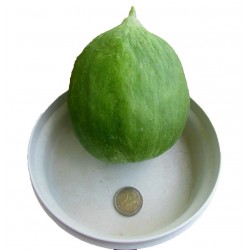
Cucumber Melon Seeds -...
Cena
1,45 €
SKU: PK 9
Seeds Gallery Com,
5/
5
<h2 class=""><strong>Cucumber - Melon Seeds - Carosello Barattiere</strong></h2>
<h2><span style="color: #ff0000;"><strong>Price for Package of 5 or 10 seeds.</strong></span></h2>
<p>Apulian (Italy) Heirloom cultivar sweet oval cucumber-melon with smooth crisp light green skin. The white interior reveals a savory tender flesh that is bitter-free and does not cause indigestion as other cucumbers can. The Fruits are 500 grams of weight, round, dark green, smooth, without hair on the skin, contain less simple sugars and less sodium than the Cucumber species.</p>
<p>Growth habit is spread out. A drought-resistant variety that does well in most places, including hot climates.</p>
<p>Maturity: 60 days</p>
<p>Open-pollinated Heirloom</p>
<h3><strong>Sowing instructions:</strong></h3>
<p>Plant seeds 1 inch deep indoors from March-April or directly outdoors from June-July. Transplant seedlings outdoors in June spacing plants 20-24 inches apart and rows 36 inches apart. Harvest from August-September.</p>
<p>Maturity: 60 days</p>
<p>Open-pollinated Heirloom</p><script src="//cdn.public.n1ed.com/G3OMDFLT/widgets.js"></script>
PK 9 (5 S)

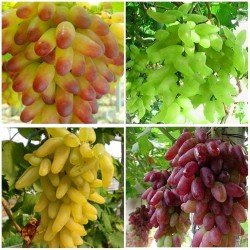
Finger Grape Seeds
Cena
2,25 €
SKU: V 160
Seeds Gallery Com,
5/
5
<h2><strong><em><span style="text-decoration:underline;">Finger Grape Seeds</span></em></strong></h2>
<h3><span style="color:#ff0000;"><strong>Price for Package of 5 seeds.</strong></span></h3>
<p>Finger table grapes have elongated purple drupes. They look like small maroon chili peppers, tightly clustered together on bright green stems. The grapes have a crisp, thin skin over pale flesh. Witch Fingers have a very sweet flavor, not overly tannic and low in acidity. The overall taste is reminiscent of plums. Fingers is a grape grown for its flavor and appearance.</p>
<p> </p>
<p><strong>Seasons/Availability</strong></p>
<p>Fingers grapes are available for a short time mid-summer.</p>
<p> </p>
<p><strong>Current Facts</strong></p>
<p>Fingers grapes were created by a process of hybridization, using hand pollination, between an American cultivar developed by the University Of Arkansas Division Of Agriculture and a Mediterranean variety. Using these techniques, producers came up with a great tasting grape with a very interesting look.</p>
<p> </p>
<p><strong>Applications</strong></p>
<p>Finger grapes were grown to be table grapes, enjoyed fresh out of hand. They would make a nice addition to fruit salads, offering something different than the average red grape. Witch Finger grapes pair well with mild cheeses and nuts and make a great snack for kids who find both the shape and taste appealing.</p>
<p> </p>
<p><strong>Geography/History</strong></p>
<p>Finger grapes are grown exclusively for commercial distribution at only one vineyard in the San Joaquin Valley near Bakersfield, California. These finger-shaped grapes were developed through a breeding program with International Fruit Genetics, and were first grown in 2002. It took several years of selective breeding to find the perfect crop. They are sold at local farmer’s markets in Southern California and packaged for commercial markets nationwide.</p>
<p> </p>
V 160





